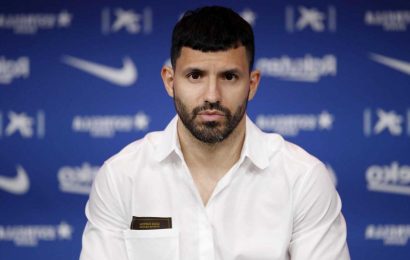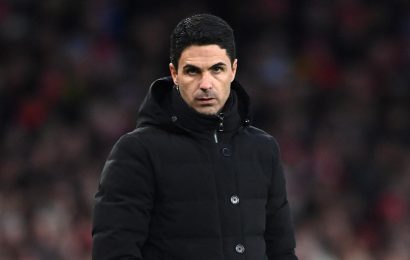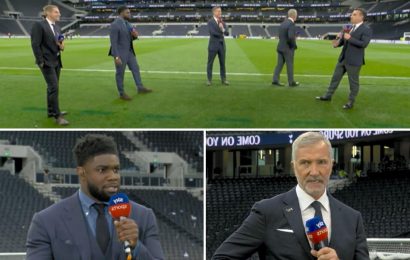WEST LAFAYETTE, Ind. — Zach Edey, the Big Ten men’s basketball player of the year, has grown exhausted, sometimes demoralized, by the focus on his body, which, at 7-foot-4 and 305 pounds, towers cartoonishly over students at Purdue University.
As his team surged to the top national ranking this season, Edey, a junior from Toronto, picked walking paths around campus that limited encounters with his shorter classmates — “the back alleys, the little side streets,” he said. He skipped football games, where fans would stop him for selfies “every two steps.” He grew wary of leaving his house.
“If I look around, I’m going to look around, I’m going to see everyone kind of staring at me with big eyes,” he said on a recent afternoon in the team’s offices. “I can walk with my friends. They’ll notice it and they’ll be like, ‘Everyone’s staring at you. This is so weird.’”
Edey is a reluctant sensation on an anachronistic team taking risks that few others at the top of the sport do, rejecting the transfer portal and playing by necessity without N.B.A. lottery picks. Instead, the Boilermakers roll through Edey, a big man with a pace more reminiscent of Shaquille O’Neal than Kevin Durant.
The vulnerabilities of the system are apparent: Fourth-seeded Virginia, which has also thrived with less-celebrated recruits, lost on Thursday to 13th-seeded Furman.
The Big Ten, rich with successful college basketball programs, has not won a men’s national championship since Michigan State’s win over Florida in 2000. Purdue, a No. 1 seed in this N.C.A.A. tournament, has made the round of 16 six times under its coach, Matt Painter, though it has won only one of those games. It has never won a national championship. Last season, the Boilermakers flamed out with a splashy loss to tiny St. Peter’s University, a casualty of the unlikeliest run in last year’s tournament.
Over four days on campus as the team prepared for this postseason, players, coaches and administrators spoke candidly about the pressures and anxieties — competitive, social, academic and financial — that come with meeting expectations on their own terms. They open play in the N.C.A.A. tournament on Friday against the No. 16-seeded Fairleigh Dickinson.
Painter, sitting at his cluttered conference room table, said that Purdue was peaking. The team spent nearly two months this season at No. 1 after briefly holding that spot last season. It won the Big Ten regular season title, then the conference tournament last weekend in Chicago. Edey, who is widely expected to be named the national player of the year, scored 62 points in the final two games of the tournament.
“We can win it all,” Mason Gillis, a junior on the team, said on Thursday before Purdue practiced in Columbus, where it will play on Friday. “We have the pieces.”
Painter, tall and burly with tightly slicked hair, has led Purdue since 2005, when he replaced Gene Keady, a 25-year coach at the university who maintains exalted status in West Lafayette.
In a basketball-crazed state, Painter is religiously committed to Indiana talent, relying on networks he has nurtured with longtime high school and youth coaches. He grew up in Muncie, Ind., and spends significant time in small high school gyms, recruiting “like an assistant,” said Mike Bobinski, the Purdue athletic director. Four of the team’s five starters and 10 of the roster’s 16 players this season are from Indiana.
Still, coaches on the team acknowledged that part of this model was not by choice.
“We run into a wall where we can’t get certain guys,” Painter said. “And so you get mad about it, and then you still recruit them, which is ridiculously stupid. You know, don’t try to date someone you can’t date. And so you go through this process of time where you’re like, ‘What am I doing?’”
The team struck gold in 2019 with Jaden Ivey, a slashing Mishawaka, Ind., recruit who quickly blossomed into a top N.B.A. pick last year. Ivey ended up at Purdue partly because he was overlooked.
Edey, the lone non-Indiana native in Purdue’s starting lineup, was the 440th-ranked player in his class. He has increased his playing time and scoring in each of his three seasons with the Boilermakers, and now averages more than 22 points and nearly 13 rebounds.
Purdue is surrounded in both rankings and the N.C.A.A. tournament bracket by teams that have successfully harnessed transfers, plugging them in to partially composed teams.
But Painter said that keeping players from their freshman to their senior years allows him to better project his teams ahead of time and helps his players mature in roles that complement others. The team has just one transfer this season, a role player named David Jenkins Jr., who is now playing at his fourth school. He said that new transfer rules help players like him find better fits.
Purdue took no transfers last season.
“Everyone is going to have to get heavy in the portal at some time. It just hasn’t happened for us yet,” Painter said.
Hunting for hidden gems, Painter relies on personality evaluations called “DiSC assessments,” which the team’s assistants give to potential recruits. That analysis, Painter says, helps determine a player’s capacity to be coached.
Among the coachable, according to the assessment: Braden Smith, a slight, goateed freshman point guard from Westfield, Ind. Little-noticed by other Division I programs until Purdue swooped in, he led the Boilermakers in assists and steals.
Painter is defiant about his approach. What if he could have D.J. Wagner, a Kentucky commitment and an N.B.A. prospect considered the top recruit in next year’s class? “I wouldn’t take him," Painter said, “because of Braden Smith.”
The pressures of college athletics drag on the team. As Purdue’s players relaxed in armchairs in a team meeting room last Tuesday, they talked with Kelsey Dawson, a sports psychologist at the university who is traveling with the team during the N.C.A.A. tournament. Several players confided that they were struggling with their confidence. Many were having trouble sleeping.
Dr. Dawson tried steering them away from their phones and video games. She suggested writing in a journal, drinking tea, making to-do lists and watching television shows they had already seen. One player said he had luck walking around until he felt tired.
Trey Kaufman-Renn, a redshirt freshman on the team who serves as the backup to Edey, unwinds by reading Immanuel Kant and Jeremy Bentham. “Descartes is probably my favorite,” Kaufman-Renn, a dedicated philosophy major and aspiring lawyer, said before a practice. “I’ve already read Descartes’ ‘Meditations,’ but we’re going over it again.” He said he planned to take the book on the road for the postseason.
Purdue runs more than 250 offensive plays organized in around half a dozen categories, an elaborate playbook that players memorize in early morning workouts in the weeks before the season begins.
The sets have esoteric names that Terry Johnson, an assistant coach, draws on a white board and flashes at his team during games: Horns Blast, G4 Blast, SW7 Point. The core of the team’s strategy is simple and old-fashioned: A pass to the low post to Edey, preferably in his favorite position just beneath and to the left of the basket, where he likes to pivot left for a hook shot, right for a layup, or turn around for a dunk, which requires little elevation.
If he doesn’t have room to score, Edey can pass it back to a shooter or another teammate who might be open because of a double-team.
Purdue’s coaches say that much of Edey’s success occurs with his positioning before he gets the ball, when he nudges opposing big men with his shoulders, back and behind, spins, shuffles and raises his right arm high to call for the ball. Brandon Brantley, a former Purdue big man and now a coach for the team, wears large cushioned covers on his hands in practices and before games, knocking Edey to simulate physical pressure from other big men. “You’re soft, you’re soft,” a smiling Brantley teases Edey as he crowds him, a strategy that Brantley says motivates his star center.
Late one afternoon, Edey squeezed into a chair in Brantley’s cramped Mackey Arena office to review game film from the team’s final regular season game against Illinois. Edey watched as he made a hook shot from just inside the free throw line. “That’s it right there,” he said. Brantley beamed. “That,” he said, “is Kareem Abdul-Jabbar!”
But the mood in Brantley’s office turned tense. Edey, who plays mostly expressionless, grew upset about missed foul calls as players banged against him. In the second half, Illinois began triple-teaming him more. The score tightened. Swarmed, Edey struggled, missing a series of shots in the final 10 minutes. Then came a breakthrough: With the game tied, Edey spun, then thrust at the hoop for a layup with his left hand, reclaiming the lead with 57 seconds to go. Purdue won 76-71.
Brantley looked at Edey in his office, hoping to inspire confidence. “We’ve been in this position a whole lot, right? Look what you do: Play on two feet, transfer the ball, step through, layup.”
“They can’t take everything away,” Brantley said to his pupil, referring to his opponents.
Too large for hockey and baseball, his favorite sports, Edey began playing competitive basketball only in 2018 — partly to stay in shape for baseball. He wanted to focus on one sport in high school, Julia Edey, his mother, said. He grew eight inches around middle school, then from 6-foot-10 to 7-foot-2 midway through high school, when family friends talked him into playing organized basketball.
Edey’s future is uncertain. He is an awkward potential fit in the N.B.A., a league that once valued traditional low-post big men but that now prioritizes lanky wing players. Chet Holmgren, a 7-foot-1 star at Gonzaga who was selected second overall in the N.B.A. draft last year, plays a starkly different style to Edey. So does Victor Wembanyama, a 7-foot-2 French player who is expected to be selected first overall in this year’s draft.
“I think as long as I’m trying my best to be an elite basketball player, there will be a role for me,” Edey said. A promise from teams that he would be a first-round selection would likely spell his departure from West Lafayette. Still, he conceded that another year at Purdue would help advance his game.
The best college basketball player might have to keep playing college basketball, Painter and other Purdue coaches acknowledged in interviews.
“I think it’ll be close,” Painter said.
Purdue was unranked to begin the season. But on Nov. 15, it beat Marquette, now a No. 2 seed in the tournament. Later that month, Purdue beat Gonzaga, another college basketball giant, by 18. Two days later, it dispatched Duke by 19. The team still views itself as an underdog; Smith, the freshman point guard, said his mother cried after the Duke and Gonzaga games, overcome by Purdue’s triumph over the famed programs.
Purdue’s run as the nation’s No. 1 team sputtered in the Big Ten conference season in early February, when it lost four of six games, including two to rival Indiana.
As the losses piled up, Edey, whose face adorns soda cups at Mackey Arena and shirts in campus stores, asked staff to excuse him from longer conversations with reporters.
“I’ve answered every question probably at least 100 times by now,” Edey said. “I’ve always been a quiet guy. I’d rather just observe conversations and observe people.”
Julia Edey said that her son’s height “makes him the person he is.” But she said that for some of his observers, the “only thing people know about you is basketball.”
“You’re so seen and yet you’re not seen at the same time,” she said.
Edey is most comfortable when he is secluded with friends. “They’ll never ask me about my height,” he said. “They just see Zach, and he’s 7-4. Whereas other people see the 7-4 Zach.”
As Purdue neared the end of its final practice before its conference tournament last week, Edey had a momentary injury scare, landing uncomfortably and letting out a yelp that filled an empty Mackey Arena. His teammates and coaches went quiet.
From midcourt, Painter saw Edey moving normally as he got back into position. With Keady, his mentor, watching from a few feet away, Painter shouted for his players to resume practice.
Source: Read Full Article








